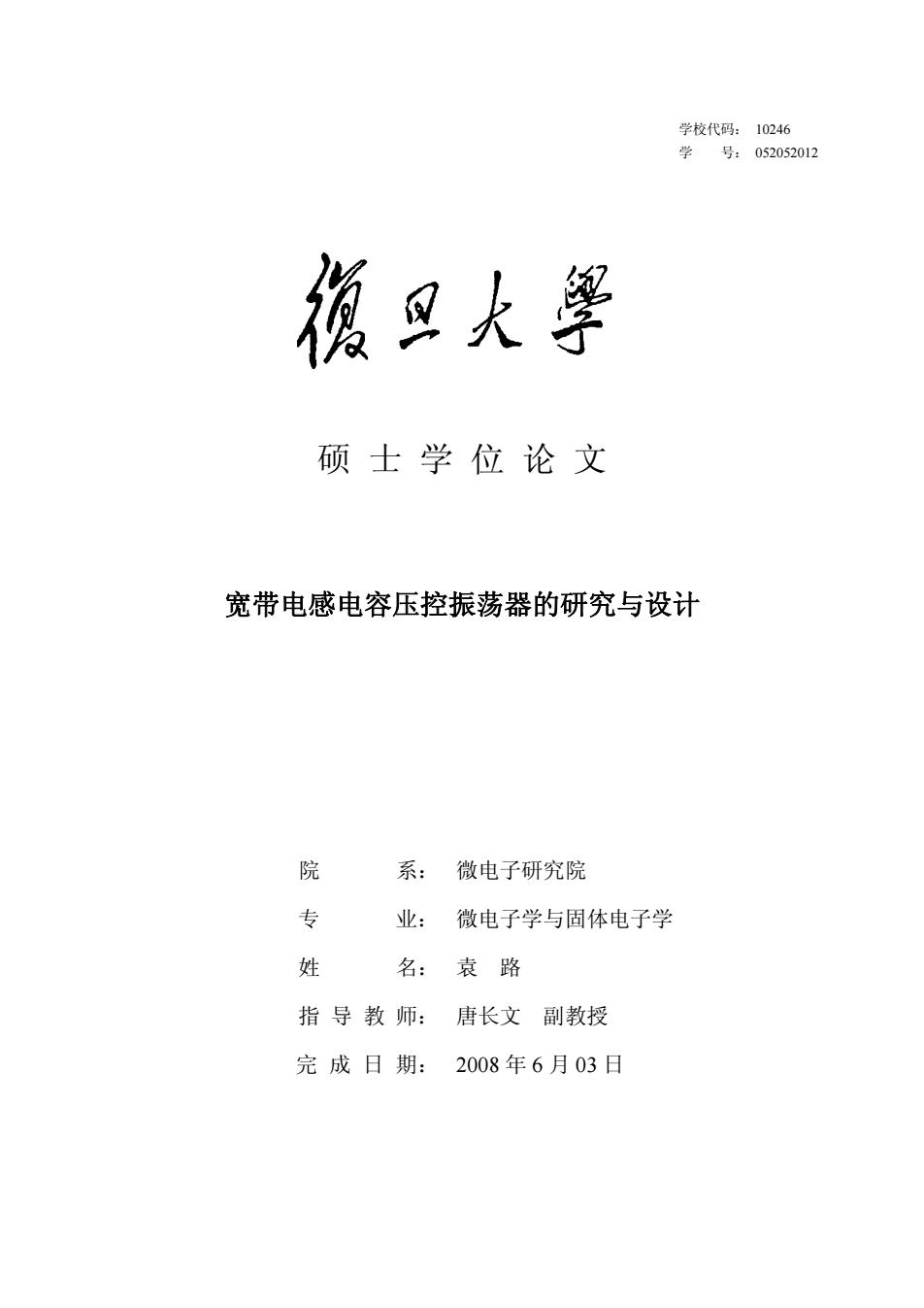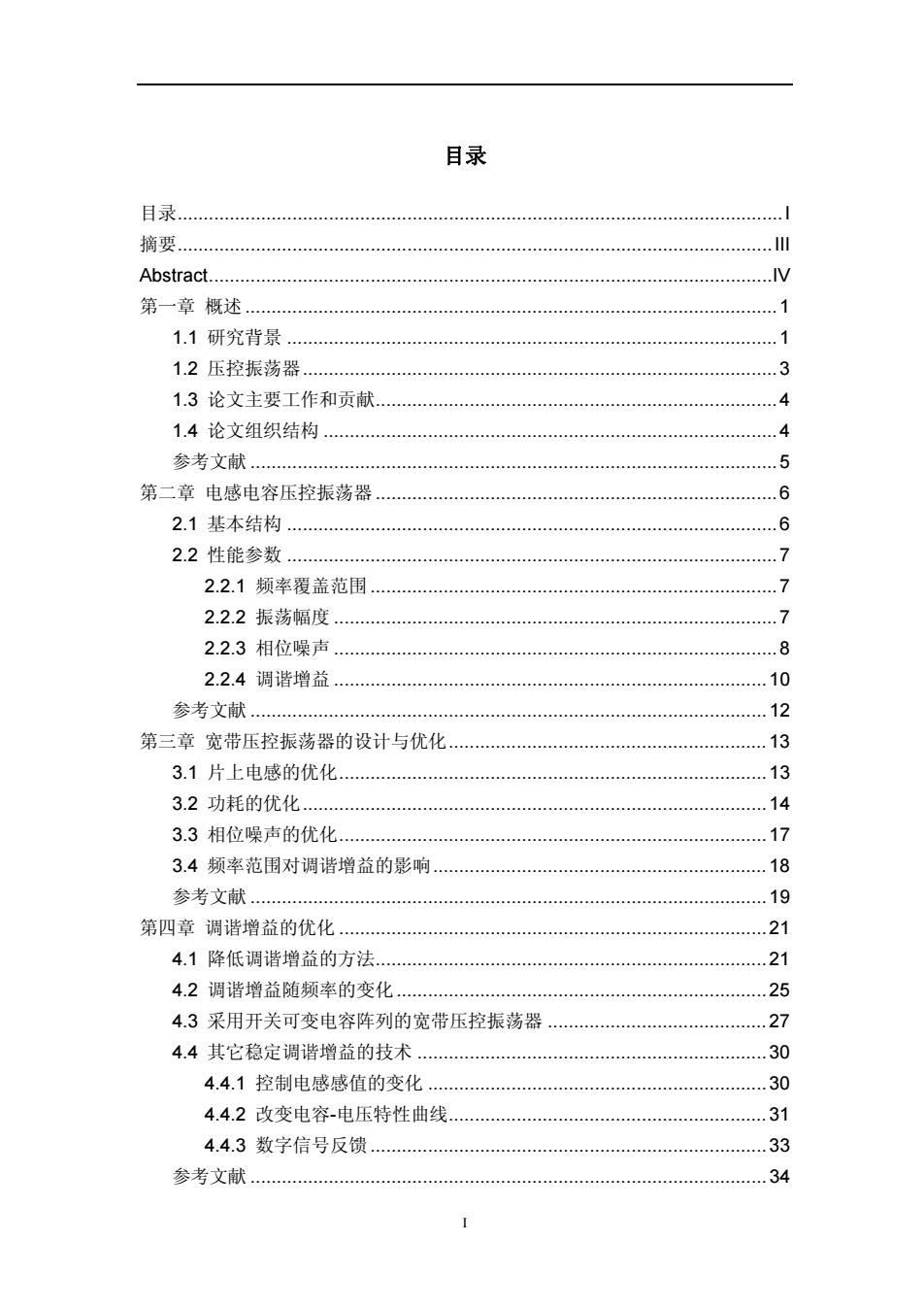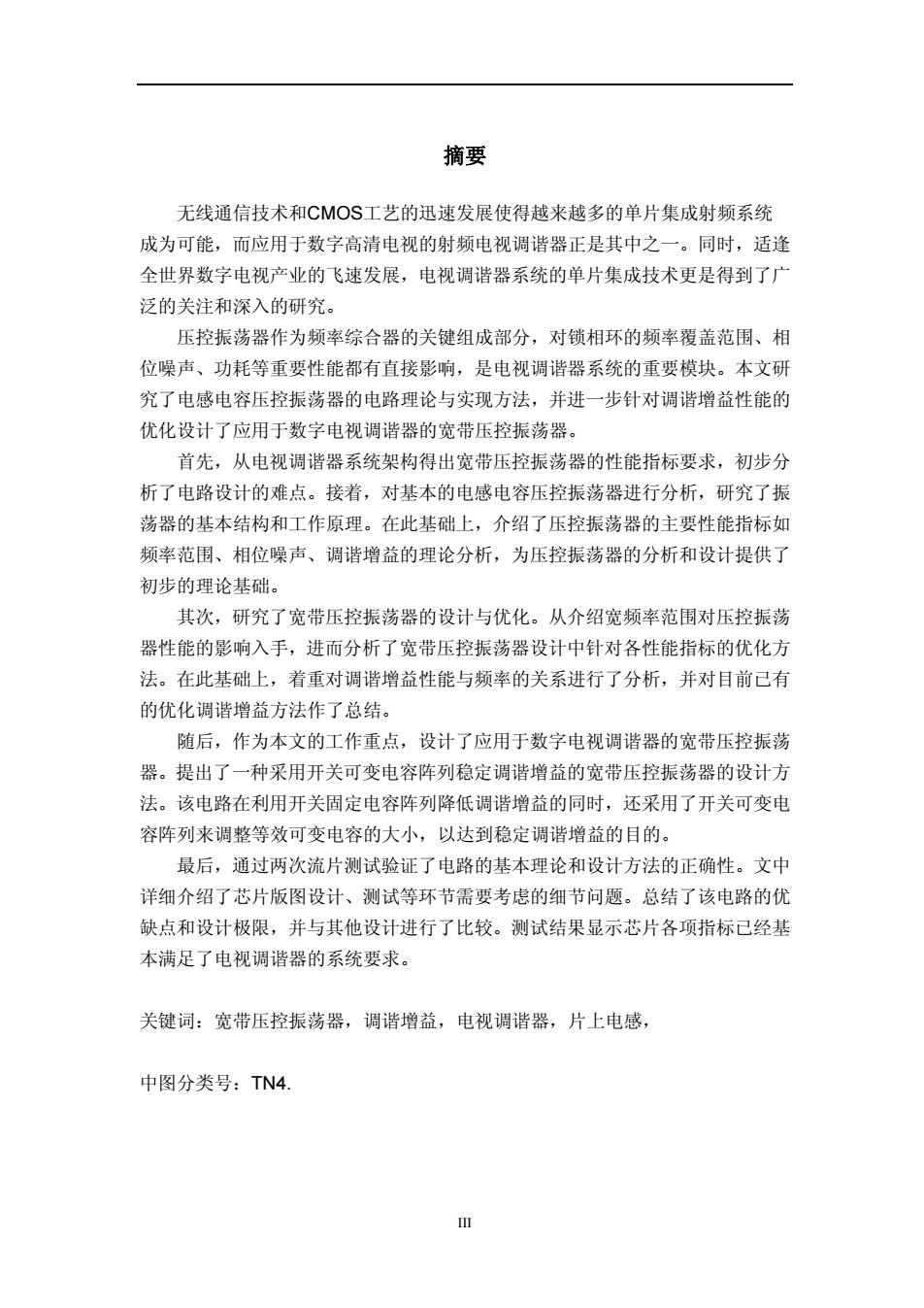
学校代码:10246 学号:052052012 復大婴 硕士学位论文 宽带电感电容压控振荡器的研究与设计 院 系: 微电子研究院 专 业: 微电子学与固体电子学 姓 名:袁路 指导教师: 唐长文副教授 完成日期:2008年6月03日
学校代码: 10246 学 号: 052052012 硕 士 学 位 论 文 宽带电感电容压控振荡器的研究与设计 院 系: 微电子研究院 专 业: 微电子学与固体电子学 姓 名: 袁 路 指 导 教 师: 唐长文 副教授 完 成 日 期: 2008 年 6 月 03 日

目录 目录… 摘要。 Abstract..... IV 第一章概述 1.1研究背景 、.7 1.2压控振荡器 3 1.3论文主要工作和贡献 A 1.4论文组织结构 4 参考文献 5 第二章电感电容压控振荡器 6 2.1基本结构 6 2.2性能参数 2.2.1频率覆盖范围 2.2.2振荡幅度 1 2.2.3相位噪声 d 2.2.4调谐增益 10 参考文献 12 第三章宽带压控振荡器的设计与优化 13 3.1片上电感的优化 13 3.2功耗的优化 14 3.3相位噪声的优化 17 3.4频率范围对调谐增益的影响 18 参考文献 19 第四章调谐增益的优化 21 4.1降低调谐增益的方法. 21 4.2调谐增益随频率的变化 25 4.3采用开关可变电容阵列的宽带压控振荡器 27 4.4其它稳定调谐增益的技术 30 4.4.1控制电感感值的变化 30 4.4.2改变电容-电压特性曲线, 31 4.4.3数字信号反馈 33 参考文献 34
I 目录 目录....................................................................................................................I 摘要..................................................................................................................III Abstract............................................................................................................IV 第一章 概述 ......................................................................................................1 1.1 研究背景 ..............................................................................................1 1.2 压控振荡器...........................................................................................3 1.3 论文主要工作和贡献.............................................................................4 1.4 论文组织结构 .......................................................................................4 参考文献 .....................................................................................................5 第二章 电感电容压控振荡器 .............................................................................6 2.1 基本结构 ..............................................................................................6 2.2 性能参数 ..............................................................................................7 2.2.1 频率覆盖范围..............................................................................7 2.2.2 振荡幅度 .....................................................................................7 2.2.3 相位噪声 .....................................................................................8 2.2.4 调谐增益 ...................................................................................10 参考文献 ...................................................................................................12 第三章 宽带压控振荡器的设计与优化.............................................................13 3.1 片上电感的优化..................................................................................13 3.2 功耗的优化.........................................................................................14 3.3 相位噪声的优化..................................................................................17 3.4 频率范围对调谐增益的影响................................................................18 参考文献 ...................................................................................................19 第四章 调谐增益的优化 ..................................................................................21 4.1 降低调谐增益的方法...........................................................................21 4.2 调谐增益随频率的变化.......................................................................25 4.3 采用开关可变电容阵列的宽带压控振荡器 ..........................................27 4.4 其它稳定调谐增益的技术 ...................................................................30 4.4.1 控制电感感值的变化 .................................................................30 4.4.2 改变电容-电压特性曲线.............................................................31 4.4.3 数字信号反馈............................................................................33 参考文献 ...................................................................................................34

第五章低调谐增益变化的宽带振荡器设计 36 5.1振荡器基本结构 36 5.2片上电感 37 5.3开关可变电容阵列 38 5.4开关电容阵列 39 5.5电平移位电路 41 5.6二次谐波谐振 45 参考文献 45 第六章芯片实现与测试 47 6.1采用开关可变电容阵列的宽带压控振荡器 47 6.1.1芯片实现 47 6.1.2测试方案 51 6.1.3测试结果 51 6.2应用于电视调谐器的宽带压控振荡器 54 6.2.1芯片实现 54 6.2.2仿真与测试结果 54 6.3测试结果小结 56 参考文献 57 第七章总结与未来展望 58 7.1论文总结 58 7.2未来展望 58 致谢. 59
II 第五章 低调谐增益变化的宽带振荡器设计......................................................36 5.1 振荡器基本结构..................................................................................36 5.2 片上电感 ............................................................................................37 5.3 开关可变电容阵列 ..............................................................................38 5.4 开关电容阵列 .....................................................................................39 5.5 电平移位电路 .....................................................................................41 5.6 二次谐波谐振 .....................................................................................45 参考文献 ...................................................................................................45 第六章 芯片实现与测试 ..................................................................................47 6.1 采用开关可变电容阵列的宽带压控振荡器 ..........................................47 6.1.1 芯片实现 ...................................................................................47 6.1.2 测试方案 ...................................................................................51 6.1.3 测试结果 ...................................................................................51 6.2 应用于电视调谐器的宽带压控振荡器..................................................54 6.2.1 芯片实现 ...................................................................................54 6.2.2 仿真与测试结果.........................................................................54 6.3 测试结果小结 .....................................................................................56 参考文献 ...................................................................................................57 第七章 总结与未来展望 ..................................................................................58 7.1 论文总结 ............................................................................................58 7.2 未来展望 ............................................................................................58 致谢.................................................................................................................59

摘要 无线通信技术和CMOS工艺的迅速发展使得越来越多的单片集成射频系统 成为可能,而应用于数字高清电视的射频电视调谐器正是其中之一。同时,适逢 全世界数字电视产业的飞速发展,电视调谐器系统的单片集成技术更是得到了广 泛的关注和深入的研究。 压控振荡器作为频率综合器的关键组成部分,对锁相环的频率覆盖范围、相 位噪声、功耗等重要性能都有直接影响,是电视调谐器系统的重要模块。本文研 究了电感电容压控振荡器的电路理论与实现方法,并进一步针对调谐增益性能的 优化设计了应用于数字电视调谐器的宽带压控振荡器。 首先,从电视调谐器系统架构得出宽带压控振荡器的性能指标要求,初步分 析了电路设计的难点。接着,对基本的电感电容压控振荡器进行分析,研究了振 荡器的基本结构和工作原理。在此基础上,介绍了压控振荡器的主要性能指标如 频率范围、相位噪声、调谐增益的理论分析,为压控振荡器的分析和设计提供了 初步的理论基础。 其次,研究了宽带压控振荡器的设计与优化。从介绍宽频率范围对压控振荡 器性能的影响入手,进而分析了宽带压控振荡器设计中针对各性能指标的优化方 法。在此基础上,着重对调谐增益性能与频率的关系进行了分析,并对目前已有 的优化调谐增益方法作了总结。 随后,作为本文的工作重点,设计了应用于数字电视调谐器的宽带压控振荡 器。提出了一种采用开关可变电容阵列稳定调谐增益的宽带压控振荡器的设计方 法。该电路在利用开关固定电容阵列降低调谐增益的同时,还采用了开关可变电 容阵列来调整等效可变电容的大小,以达到稳定调谐增益的目的: 最后,通过两次流片测试验证了电路的基本理论和设计方法的正确性。文中 详细介绍了芯片版图设计、测试等环节需要考虑的细节问题。总结了该电路的优 缺点和设计极限,并与其他设计进行了比较。测试结果显示芯片各项指标己经基 本满足了电视调谐器的系统要求。 关键词:宽带压控振荡器,调谐增益,电视调谐器,片上电感, 中图分类号:TN4 I
III 摘要 无线通信技术和CMOS工艺的迅速发展使得越来越多的单片集成射频系统 成为可能,而应用于数字高清电视的射频电视调谐器正是其中之一。同时,适逢 全世界数字电视产业的飞速发展,电视调谐器系统的单片集成技术更是得到了广 泛的关注和深入的研究。 压控振荡器作为频率综合器的关键组成部分,对锁相环的频率覆盖范围、相 位噪声、功耗等重要性能都有直接影响,是电视调谐器系统的重要模块。本文研 究了电感电容压控振荡器的电路理论与实现方法,并进一步针对调谐增益性能的 优化设计了应用于数字电视调谐器的宽带压控振荡器。 首先,从电视调谐器系统架构得出宽带压控振荡器的性能指标要求,初步分 析了电路设计的难点。接着,对基本的电感电容压控振荡器进行分析,研究了振 荡器的基本结构和工作原理。在此基础上,介绍了压控振荡器的主要性能指标如 频率范围、相位噪声、调谐增益的理论分析,为压控振荡器的分析和设计提供了 初步的理论基础。 其次,研究了宽带压控振荡器的设计与优化。从介绍宽频率范围对压控振荡 器性能的影响入手,进而分析了宽带压控振荡器设计中针对各性能指标的优化方 法。在此基础上,着重对调谐增益性能与频率的关系进行了分析,并对目前已有 的优化调谐增益方法作了总结。 随后,作为本文的工作重点,设计了应用于数字电视调谐器的宽带压控振荡 器。提出了一种采用开关可变电容阵列稳定调谐增益的宽带压控振荡器的设计方 法。该电路在利用开关固定电容阵列降低调谐增益的同时,还采用了开关可变电 容阵列来调整等效可变电容的大小,以达到稳定调谐增益的目的。 最后,通过两次流片测试验证了电路的基本理论和设计方法的正确性。文中 详细介绍了芯片版图设计、测试等环节需要考虑的细节问题。总结了该电路的优 缺点和设计极限,并与其他设计进行了比较。测试结果显示芯片各项指标已经基 本满足了电视调谐器的系统要求。 关键词:宽带压控振荡器,调谐增益,电视调谐器,片上电感, 中图分类号:TN4

Abstract The rapidly progress on wireless-communication and CMOS technology makes more and more radio frequency (RF)systems integrated in a System-On-a-Chip(SOC)to be possible.One of them is the RF TV tuner for digital High-Definition Television (HDTV).With the development of digital TV industry,the TV tuner system has gained widely attention and deeply research. As an important part of the frequency synthesizer,Voltage-Controlled Oscillator (VCO)is one of the critical circuits in TV tuner system.This work focuses on the wideband LC VCO design for TV tuner application,including circuit theory analysis,chip implement and measurement. Firstly,a double-conversion low-IF TV tuner system architecture is presented,from which the wideband VCO specification is derived.And the base LC-VCO architecture is researched,theory analysis of the power,phase noise and tuning gain are presented in detailed. Secondly,the wideband VCO design and optimize methodology is presented.Based on the theory analysis,a relationship between the wide frequency range and tuning gain is researched. The design of fully-differential wideband VCO with stable tuning gain is the principal part of this paper.A switched varactor array in a single-inductor VCO is proposed to suppress the tuning gain (KVCO)fluctuation.By choosing the unit varactor of the array carefully,the KVCO variation can be significantly reduced Finally,the chip design and measurement results are presented.The chip achieves good performance in the required frequency band,and can be satisfy the TV tuner application. Key Words:Wide-Band LC Voltage-Controlled Oscillator,Tuning Gain,TV tuner,on-chip inductor N
IV Abstract The rapidly progress on wireless-communication and CMOS technology makes more and more radio frequency (RF) systems integrated in a System-On-a-Chip (SOC) to be possible. One of them is the RF TV tuner for digital High-Definition Television (HDTV). With the development of digital TV industry, the TV tuner system has gained widely attention and deeply research. As an important part of the frequency synthesizer, Voltage-Controlled Oscillator (VCO) is one of the critical circuits in TV tuner system. This work focuses on the wideband LC VCO design for TV tuner application, including circuit theory analysis, chip implement and measurement. Firstly, a double-conversion low-IF TV tuner system architecture is presented, from which the wideband VCO specification is derived. And the base LC-VCO architecture is researched, theory analysis of the power, phase noise and tuning gain are presented in detailed. Secondly, the wideband VCO design and optimize methodology is presented. Based on the theory analysis, a relationship between the wide frequency range and tuning gain is researched. The design of fully-differential wideband VCO with stable tuning gain is the principal part of this paper. A switched varactor array in a single-inductor VCO is proposed to suppress the tuning gain (KVCO) fluctuation. By choosing the unit varactor of the array carefully, the KVCO variation can be significantly reduced. Finally, the chip design and measurement results are presented. The chip achieves good performance in the required frequency band, and can be satisfy the TV tuner application. Key Words: Wide-Band LC Voltage-Controlled Oscillator, Tuning Gain, TV tuner, on-chip inductor